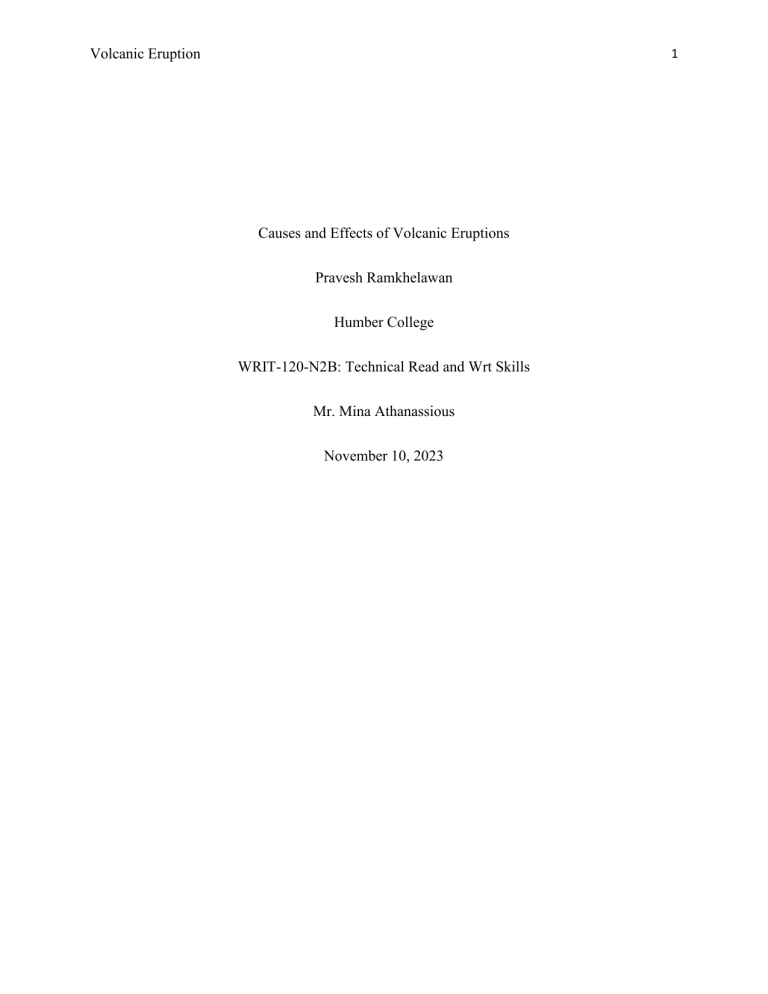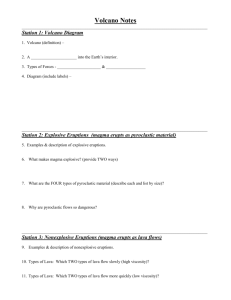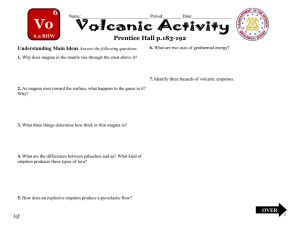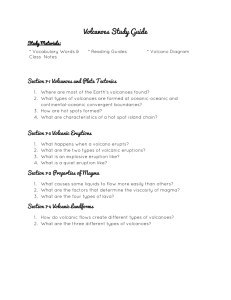
1 Volcanic Eruption Causes and Effects of Volcanic Eruptions Pravesh Ramkhelawan Humber College WRIT-120-N2B: Technical Read and Wrt Skills Mr. Mina Athanassious November 10, 2023 2 Volcanic Eruption Abstract A volcano is a naturally formed opening on a planet's surface that allows hot lava, ashes and gases from magma chambers that are located deep into a planet. Volcanoes are usually shaped like a mountain or dome and can erupt in different ways such as explosively or gently. A volcano eruption can bring about both positive and negative effects to the land surrounding it. 3 Volcanic Eruption Causes and Effects of Volcanic Eruption Volcanoes are diverse geological structures that result from the eruption of magma, volcanic ashes, and gases from deep beneath the Earth's crust. The main cause of volcanic eruptions lies in the movement of tectonic plates, which make up the Earth's outer shell. These plates are in constant motion, and their interactions at plate boundaries can lead to the formation of various types of volcanoes, including stratovolcanoes, shield volcanoes, and cinder cone volcanoes. When rocks deep inside the Earth melt, they turn into magma. Magma is lighter than the surrounding rocks, so it moves upward due to its buoyancy. If the magma is less dense than the rocks around it, it can reach the surface and cause a volcanic eruption. Magma contains gases like water, sulfur dioxide, and carbon dioxide. As magma moves up, the pressure decreases, and these gases form bubbles. When the bubbles make up about 75 percent of the magma, it breaks apart and erupts explosively. Sometimes, new magma is injected into a chamber already filled with magma. This can force the existing magma to move up and erupt (Kilnic.1999). When a volcano erupts, it causes a variety of problems for the land and the people nearby. The hot lava that emerges can burn everything in its path and cover the land, altering its appearance. Dangerous flows, known as pyroclastic flows, contain hot gases and pieces of rock that move at high speeds, capable of destroying everything in their path. The ash expelled during eruptions can blanket everything like a large, gray shroud, making it challenging for plants to grow and adversely affecting the air quality. When volcanoes close to shorelines erupt, they can sometimes cause tsunamis to occur. Additionally, mudflows called lahars, can occur when the volcano mixes with snow or ice, resembling moving rivers of mud and rocks that can cause further damage (Kilnic.1999). Volcanic Eruption Volcanic eruptions can have both positive and negative impacts on the land and the people nearby. On the positive side, when the lava cools down, it can create highly fertile soil, supporting robust plant growth and potentially leading to better crops for farmers (Kilnic.1999). However, the negative impact of volcanic eruptions is substantial; the hot lava and ash can damage homes and farmlands, making it difficult for people to recover. The ash covering the ground can hinder plant growth, posing challenges for agriculture. 4 5 Volcanic Eruption References Kilnic, A (November 29, 1999) Causes of a volcano eruption retrieved from What Causes a Volcano to Erupt, and How Do Scientists Predict Eruptions? | Scientific American








